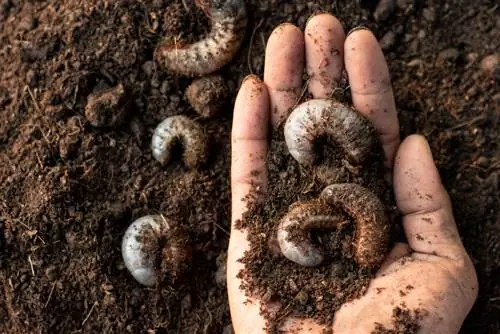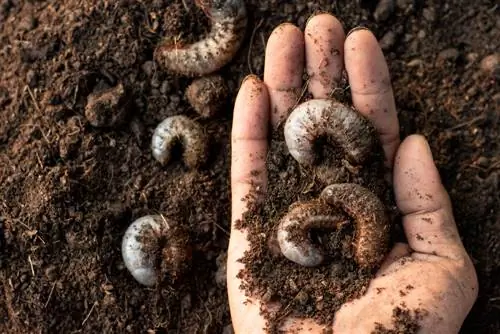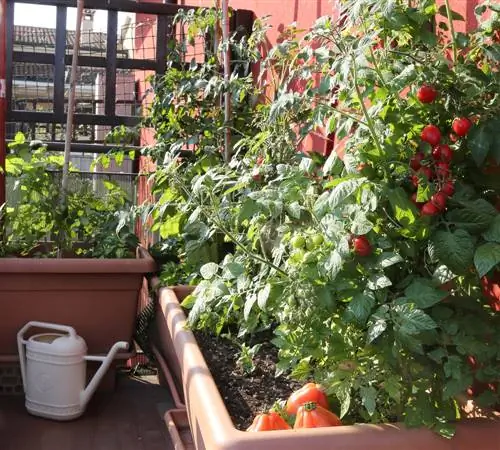- Author admin [email protected].
- Public 2024-01-05 20:48.
- Last modified 2025-01-23 11:22.
Anyone who has to complain about dead lawns and finds curved, whitish larvae in their beds or flower pots is probably dealing with grubs. Certain types of these beetle larvae are classified as pests and are therefore worth combating. There are various methods for this.

How can I successfully fight grubs in the garden?
To effectively control grubs in the garden, you can use mechanical removal, strategic control and deterrent measures. This includes digging up and collecting the larvae, using predatory nematodes, grub traps, toxic plants, deterrent plants and insect protection nets during the beetle's flight times.
What you should know about grubs
Grubs are the larvae of beetles from the genus and species-rich superfamily Scarabaeoidea. However, only a handful are relevant to local gardening. These mainly include:
- Cockchafer
- June beetles (finned curlew beetles)
- Garden leaf beetle
- rose beetle
- Rhino Beetle
The larvae of these beetle species all have a typical appearance that is usually difficult to distinguish from one another. It is characterized by the C-shaped curved shape, the clear segmentation, the light, yellowish to creamy white color and the 3 bent pairs of sternums.
Useful and harmful grubs
Who you should welcome
Not all grubs are harmful to garden crops, some are also quite useful. In order to avoid unnecessary control and not to spurn free help, it is good to be able to identify the useful species. The following are particularly useful:
- Rose beetle grubs
- Rhino Beetle Grubs
They feed exclusively on dead plant material and can therefore produce valuable permanent humus in the compost, where they prefer to live.
On the one hand, they can be identified simply by where they live in the compost. Rhinoceros beetle grubs are also noticeably large at 7-10 centimeters; funnily enough, rose beetle grubs move backwards.
Whoever causes harm
However, the following are particularly harmful:
- Cockchafer grubs and
- June beetle grubs.
They feast on the roots of living plants, especially grasses and tender vegetable and berry plants. The damage is reflected in dead, easily removable islands of lawn and caring bedding plants. Garden leaf beetle larvae also feed on living roots, but at only about one centimeter long they are significantly smaller than the 5-7 cm long May beetle and June beetle grubs and therefore cause negligible damage.
Control measures
In general, you should use gentle methods when combating grubs. Because they are best for the biological balance of your garden and the environment. The ecological, natural options can be divided into the following categories:
1. Mechanical removal
2. Strategic, targeted combat3. Deterrent and defensive measures
1. Mechanical removal
Dig up and collect
If you notice damage to lawns and bedding plants that indicates a grub infestation, you can first take the most direct route: dig up the soil on the spot and go hunting for grubs. Depending on the strength of the soil and the spread of the infestation, loss is inevitable. Catching all the grubs is pretty unlikely.
Squirting
If you have grubs in flower pots, you can also arm yourself with a garden hose or a low-pressure cleaner and spray out the root balls of individual plants.
2. Strategic Combat
Luring upwards through wetness
You can proceed a little more indirectly by luring the grubs out through intensive watering. Like earthworms, the beetle larvae are brought to the surface of the earth when it rains. So if you water a bed heavily or submerge potted plants, the pests will move to the surface where you can collect them.
Use nematodes
A fairly reliable method is the use of predatory nematodes. Such parasitic roundworms colonize the grubs and release bacteria into their bloodstream that kill them. Predatory nematodes of the predatory genus Heterorhabditis (€29.00 on Amazon), which can be purchased from garden shops or online and can be applied via irrigation water, are suitable.
Grub Trap
An effective and gentle method that also requires patience is a grub trap. It is easy to set up and brings the pests together in one place where they can then be removed in one go. Fill a bucket with horse manure up to just below the rim and bury it in the garden soil in the affected area. It should remain there for a year until the grubs have crawled into the tempting dung and can simply be removed from the ground along with the bucket.
Deadly Plants
Some plants are toxic to grubs - and yet they don't stop at their roots when they eat them. So you unknowingly kill yourself. These plants include geraniums and delphiniums.
3. Deterrent and defensive measures
Deterring Plants
Certain plants have a deterrent effect on the adult beetles and prevent them from laying eggs. This primarily includes garlic. If you plant garlic plants in beds and balcony pots, you can prevent grub colonization.
Insect protection nets
Putting up insect protection nets when the beetles are flying makes a lot of sense so that you don't get into trouble with the larvae in the first place. In order to be able to initiate the measure in a timely manner, it is of course necessary to follow the May and June beetle years and to prepare the nets from May onwards in corresponding years.
Insecticides
Insecticides should always be the last resort. After all, they not only kill unwanted pests in an unsightly way, but also beneficial insects and plants. Products available in specialist retailers include products such as the harmful Kwizda Agritox EngerlingFrei, “Against grubs in the lawn” from Bayer or lime nitrogen granules.






